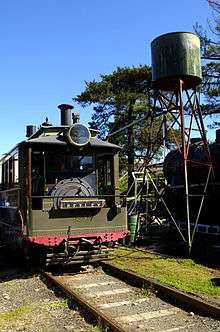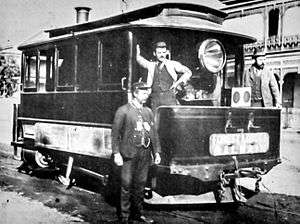Sydney Steam Motor Tram
| NSWGT Steam Motor Trams (Sydney) | |
|---|---|
|
Baldwin Tram Motor No. 7 at Balmain, New South Wales | |
| Manufacturer |
Baldwin Locomotive Works Randwick Tramway Workshops Henry Vale T. Wearne |
| Designer | Baldwin Locomotive Works |
| Constructed | 1879-1923 |
| Specifications | |
| Train length | 17 feet 2 inches (5,232.400 mm) |
| Width | 8 feet 6 inches (2,590.800 mm) |
| Maximum speed | 20–km/h |
| Weight | 14.3 t |
| Track gauge | 4 feet 8 1⁄2 inches (1,435.100 mm) |
.jpg)
The Steam tram motors were built for and operated by the New South Wales Government Tramways of Australia.
History
Steam trams were introduced when four steam tram motors imported to Sydney as a temporary transport for the International Exhibition of 1879. It was built at the Baldwin Locomotive Works, Philadelphia, U.S.A. and hauled double decker trailers conveying passengers from the Redfern railway terminus to near the Botanic Gardens [1]
Beyer Peacock Steam Tram No 2464 of 1885 was exported to Australia in 1886 as a trial unit by the NSWGT for comparison against the Baldwin steam tram. The Baldwin design prevailed and this engine returned to the UK in 1889 to become Beyer Peacock works shunter No.2. The engine is rumoured to have fallen into the sea on its way from New South Wales to Manchester, before delivery to Beyer Peacock.[2]
Design
The steam tram motor is basically a small enclosed saddle tank locomotive steam motor with four driving wheels in an 0-4-0 arrangement. A wooden cab encloses the entire locomotive, which features five windows along each side. Access to the cab is through doors from either the front or back platform. The tram is powered by an orthodox locomotive type boiler, American bar type framing, conventional "D" type slide valves and spring suspension. Coke and later coal was carried in a bunker on the rear platform and water in the semi-circular saddle tank.
Typical specifications for an 11" Baldwin steam tram motor:
- Cylinders: 11" diameter x 16" stroke
- Tractive Effort: 120 psi steam, 5,500 lb at 10 mph
- Weight: 14 tons 2 cwt
- Length: 17 feet 2 inches
- Width: 8 feet 6 inches
Service
The Redfern to Botanic Gardens tramway was planned to operate for the duration of the exhibition. Proving so popular an extension to Randwick was opened in 1880. The peak of steam working was reached during 1894, when the length of the tramway reached 40 miles (64.7 km) when there were over 100 steam trams in service. In 1905-6 steam tram routes were replaced by electric trams with steam trams gradually relegated to outer suburbs.
Steam Tram Motors in service were:
| Steam Tram Motors | ||||||||
|---|---|---|---|---|---|---|---|---|
| Builder | Date | Cyl Diam. | Original Nos. | Total | ||||
| Baldwin | 1879 | 11 inch | 1,2,3,4 | 4 | ||||
| Baldwin | 1880 | 11 inch | 5-10 | 6 | ||||
| Baldwin | 1881 | 10 inch | 11,13,15-18,26 | 7 | ||||
| Baldwin | 1881 | 11 inch | 12, 14, 19-25 | 9 | ||||
| Baldwin | 1881 | 9 inch | 27-30 | 4 | ||||
| Baldwin | 1882 | 9 inch | 31-33 | 3 | ||||
| Baldwin | 1882 | 10 inch | 44,45 | 2 | ||||
| Baldwin | 1882 | 11 inch | 34-41 | 8 | ||||
| Baldwin | 1883 | 10 inch | (2nd) 46,47-49,51-54,56,57 | 10 | ||||
| Baldwin | 1884 | 11 inch | 58-69 | 12 | ||||
| Baldwin | 1885 | 11 inch | 77-96 | 20 | ||||
| Baldwin | 1891 | 11 inch | (3rd) 76,(2nd) 97,98-110 | 15 | ||||
| Henry Vale | 1890 | 11 inch | (2nd) 50,(2nd) 70 (2nd) 75 | 7 | ||||
| Henry Vale | 1891 | 11 inch | (2nd) 5,(Rly) 12(2nd) 13,(2nd) 27,(2nd) 28,(2nd) 76 | 6 | ||||
| T. Wearne | 1884 | 10 inch | 76 | 1 | ||||
| T. Wearne | 1886 | 10 inch | 97 | 1 | ||||
| Randwick Workshops | 1916 | 11 inch | 126A-128A | 3 | ||||
| Randwick Workshops | 1917 | 11 inch | 129A,130A | 2 | ||||
| Randwick Workshops | 1923 | 11 inch | 131A,132A | 2 | ||||
| Randwick Workshops | 1957 | body only built for processions | 1 | |||||
Demise and Preservation
The last NSWGT steam motor was withdrawn from service in 1937 and replaced by a trolley bus service. Preserved trams are:
- Steam Tram Motor No. 1A, owned by Powerhouse Museum[3] The identity No.1A was applied by the Powerhouse Museum. It is actually Henry Vale & Co of Sydney built Steam Motor 28a. Makers number 52.[4]
- Steam Tram Motor No. 103a, [1891] at Valley Heights Steam Tramway[5] Built by Baldwin Locomotive Works in Philadelphia, Pennsylvania, USA. Makers number 11676.
- Steam Tram Motor No. 100, [1891] at Museum of Transport and Technology, Auckland. Built by Baldwin Locomotive Works in Philadelphia, Pennsylvania, USA. Makers number 11885.
Gallery
.jpg) Early Sydney Tram
Early Sydney Tram.jpg) Sydney tram, c.1885
Sydney tram, c.1885
2 trailers 'John Bull'
'John Bull' No. 1A Top View
No. 1A Top View Tram Motor No. 1A
Tram Motor No. 1A Tram Motor No. 1A
Tram Motor No. 1A No. 1A Side View
No. 1A Side View Tram Motor 103A
Tram Motor 103A Tram Motor 103A
Tram Motor 103A 103A Driving Wheel
103A Driving Wheel 103A Backplate
103A Backplate
See also
- McCarth & Chinn, "New South Wales Tramcar Handbook 1861-1961", 1974 SPER
- Burke, David, "Juggernaut: A story of Sydney in the wild Days of the Steam Trams", Kangaroo Press, Roseville, N.S.W.,1997.
- McCarthy, Ken, 'The Era of the Steam Tramway' in "Trolley Wire ", April 1973, Vol. 14 No.2.
References
- ↑ MacCowan, Ian. The Tramways of New South Wales.
- ↑ "The "Odd-Ball" Steam Tram Motor" (PDF).
- ↑ "Steam Tram Motor No. 1A, 1898". Powerhouse Museum.
- ↑ Steaming Down Argent Street - A History of the Broken Hill Steam Tramways 1902-1926.
- ↑ "Tram 103a". Valley Heights Steam Tramway.
